
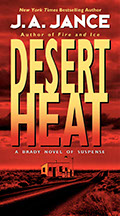 BUY NOWWHERE IS HE, GIRL?
BUY NOWWHERE IS HE, GIRL?
WHEREʼS ANDY?
Life is good for Joanna Brady in the small desert community of Bisbee. She has Jenny, her adored nine-year-old daughter, and solid, honest, and loving husband, Andy, a local lawman who’s running for Sheriff of Cochise County. But her good life explodes when a bullet destroys Andy Brady’s future and leaves him dying beneath the blistering Arizona sun.
The police brass claim that Andy was dirty–up to his neck in drugs and smuggling–and that the shooting was a suicide attempt. Joanna knows a cover-up when she hears one . . . and murder when she sees it. But her determined efforts to track down an assassin and clear her husband’s name are placing herself and Jenny in serious jeopardy. Because, in the desert, the truth can be far more lethal than a rattler’s bite.
I wasn’t allowed in the creative writing classes at the University of Arizona, but I was smart enough to figure out that I needed to write what I know. I know southeastern Arizona. I spent my childhood there, taking Sunday afternoon rides with my family and scrambling barefoot over the mesquite and bear-grass studded hills, making forts in stands of Embry’s scrub oak, and tearing down hilly streets in a kid crammed Radio Flyer.
I know the insurance business. My father spent twenty years selling life insurance. Following in his footsteps, I spent ten. I was divorced for a year and a half before my former husband died, so I know what it’s like to be left alone with a child to raise. I have half a century’s experience at being the daughter of a strong-willed mother and almost thirty years’ experience at playing the strong-willed mother with a headstrong daughter. In addition I know how small towns work–the small unasked kindnesses and the entrenched gossiping that result from everyone knowing everybody else’s business.
Is Joanna Brady autobiographical? In some ways, yes. To a certain extent, every character is. From selling insurance to being a Girl Scout to liking Malt-o-Meal, Joanna Brady’s experience is certainly a reflection of mine. But she is also very much her own woman.
JAJ
AVON (1993) ISBN 0-380-76545-4
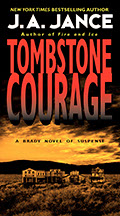 BUY NOWWHEN DRUG DEALERS MURDERED HER LAWMAN HUSBAND, JOANNA BRADY VOWED SHE WOULD CARRY ON HIS GOOD WORK– NO MATTER WHAT THE COST
BUY NOWWHEN DRUG DEALERS MURDERED HER LAWMAN HUSBAND, JOANNA BRADY VOWED SHE WOULD CARRY ON HIS GOOD WORK– NO MATTER WHAT THE COST
With grit, courage and dogged determination, Joanna challenged the status quo–and won. Now, as newly elected Sheriff of Cochise County, Arizona, she must battle the prejudice and hostility of a mistrustful, male-dominated police force–and solve a grisly double homicide that threatens to tear the sleepy desert community to pieces. For the two bodies baking in the harsh Southwestern sun are connected by sinister threads that reach back generations–and by devastating family secrets of greed, hatred and shocking abuse that could destroy the innocent along with the guilty.
When I wrote the first Beaumont book, I had no idea I was writing a series. With Joanna Brady, I knew it was a series from the beginning. In the early Eighties I was involved in a political campaign that resulted in a heart-breaking loss. That experience taught me that, in a democracy, no matter how large or small the position, running for office is an exhausting, all-consuming process. As I prepared to write Tombstone Courage, I expected the race for sheriff would take a central role, but I was due for a rude awakening.
My eleven previous books were all “police procedurals,” a literary genre and term I learned four books into the game. I had come to have a profound respect for police officers, both who they are and what they do. As a result, I found myself ill equipped to write a book with an “amateur sleuth” as the main character. Whenever Joanna started asking questions or nosing around, I would find myself telling her, “You can’t do that.”
After struggling for weeks with a terrible case of writer’s block, I finally realized that I had to skip the election and turn Joanna Brady into a sheriff from the get-go. After that, the book came together.
JAJ
AVON (1995) ISBN 0-380-76546-2
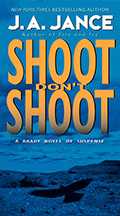 BUY NOWTHE ONLY WAY TO LEARN ALL THOSE THINGS IN A HURRY IS TO TAKE A CRASH COURSE LIKE THE ONE THEY OFFER AT THE ARIZONA POLICE OFFICERS ACADEMY
BUY NOWTHE ONLY WAY TO LEARN ALL THOSE THINGS IN A HURRY IS TO TAKE A CRASH COURSE LIKE THE ONE THEY OFFER AT THE ARIZONA POLICE OFFICERS ACADEMY
An assassin’s bullet shattered Joanna Brady’s world, leaving her policeman husband to die in the Arizona desert. But the young widow fought back the only way she knew how: by bringing the killers to justice . . .and winning herself a job as Cochise County Sheriff.
Still mourning her loss, Joanna Brady needs to be strong and supportive for her nine-year-old daughter, Jenny. She also has responsibilities to the people who elected her Sheriff. Joanna has the heart and instinct for her new job, but not the experience–which is what brings her to Phoenix for a pre-Thanksgiving crash course in police training . . . and into the mystery of an imprisoned husband her gut tells her did not murder his estranged wife. Suddenly Sheriff Brady has a lot more to worry about than classes and the visiting family pre-holiday chaos. For her impromptu investigation is drawing a serial killer too close for comfort–and closer, worse still, to Joanna’s little girl.
Writing a Joanna Brady book is a whole lot like being in therapy, only more fun. I get to write all the lines–Eleanor Lathrop’s, Joanna’s, and Jenny’s as well. In the process I’ve learned things about myself and come to terms with some of the conflicts and misunderstandings in my own family life.
When I’m writing about a character, I try to put myself inside that person’s head and react as he or she would react. If I can’t understand a particular character’s motives for doing something–if what he or she is doing or saying isn’t believable to me–then it won’t be believable for my readers, either.
Sometimes people who start out as fans become friends. That was the case with Jim and Carol Norman. When I wrote this book, I decided to pattern one character, the lady detective from Peoria, after Carol who was tiny and beautiful and whose glorious black hair resembled a mound of licorice-flavored cotton candy. At the publication party for Tombstone Courage, I told Carol about her coming appearance in Shoot/Don’t Shoot. She was excited and looking forward to her cameo appearance.
Then, after the book was written and before the book was published, Carol Norman was killed in a drunk driving incident--not accident--along the Oregon Coast. When the galleys came, I was afraid what had been a nice gesture when Carol was alive might now prove to be a further loss to her devastated husband. I called my editor and told him the situation. I asked for and received permission to change the character’s physical appearance if that was what Jim Norman wanted. He said, "no", that "Carol had been so excited about the prospect of being a character in a book that he didn’t want me to change a thing". But I did. I left the detective’s physical appearance as written, but I changed her name. . . to Carol.
JAJ
AVON (1996) ISBN 0-380-76548-9
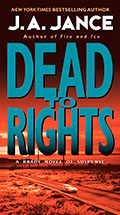 BUY NOWLEAVE HIM BE, MAN.
BUY NOWLEAVE HIM BE, MAN.
LET THE COPS TAKE CARE OF THE STUPID JERK
Joanna Brady –devoted mother and the first female Sheriff of Cochise County, Arizona–knows what it’s like to lose one you love, and her heart still aches over the murder of her policeman husband. But her sympathy for a tragically widowed ex-cop has placed Joanna’s future in jeopardy–and brought her face-to-face with death in the high, lonely desert.
On their nineteenth wedding anniversary, Hal Morgan’s wife was fatally struck down by a drunk driver–and the courts punished her killer with only a wrist-slap. A year to the day later the irresponsible motorist is murdered and all fingers are pointing to Morgan as the perpetrator–except Sheriff Brady’s. But Joanna’s gut instinct is leading her into a maelstrom of danger and deception, as she trails the truth from a ghostly mining camp to the rocky spires of the Chiricahua National Monument. Because now an assassin is turning his sights on her.
One of our friends, Carol Norman, died as a result of a drunk driving incident. After two years and with the help of Mothers Against Drunk Drivers, Carol’s husband finally saw to it that his wife's killer went to prison for–sixteen months. The prosecutor was proud of the sentence; I was offended, and I just happened to be getting ready to write a book.
The scene in the Prologue of Dead to Rights and the events surrounding the death of a fictional Bonnie Jean Morgan aren’t exactly what happened to Jim and Carol Norman, but they are close enough that when I was on tour with this book I was unable to read the Prologue aloud at book signings because it choked me up. I couldn’t get the words to come out past the lump in my throat.
Bearing that in mind, it’s hardly surprising that the drunken character behind the wheel of the speeding car in my book doesn’t make it to the end of the first chapter. Rubbing him out felt good to me. Maybe the pen really is mightier than the sword.
JAJ
AVON (1997) ISBN 0-380-97394-4
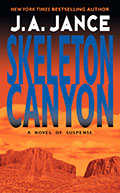 BUY NOWSHE WAS SMOOTH AND PALE AND BEAUTIFUL AND AS UNASHAMEDLY NAKED AS THE DAY SHE WAS BORN
BUY NOWSHE WAS SMOOTH AND PALE AND BEAUTIFUL AND AS UNASHAMEDLY NAKED AS THE DAY SHE WAS BORN
Brianna “Bree” O’Brien never returned from Skeleton Canyon. Someone brutally murdered the pretty, popular teenager who had stolen away under cover of darkness to rendezvous with her boyfriend, Ignacio Ybarra. Perhaps youthful rage, jealousy and savage passion cost young Bree her life. Or maybe she stumbled onto something too dangerous to know.
Sheriff Joanna Brady of Cochise County knows only too well the pain of losing a loved one to violence. But she is disturbed by the O’Briens’ blind insistence that Ignacio is responsible for their daughter’s slaying. Joanna senses there are words not being spoken, and dark mysteries locked behind doors of the sprawling O’Brien family compound. But it is the strange disappearance of a good friend that is pulling Sheriff Brady ever closer to the lethal nest of lies, greed and secrets hiding in a desolate corner of the Arizona desert - where the next blood that feeds the parched, cracked earth could be her own.
In the early Sixties one of my sisters owned a small ranch near Bisbee Junction. On this ranch, ee-yi-ee-yi-o, there was a horse named Warpaint, a cow named Shirley, a pig with no name, and a three-legged Australian shepherd named Smokey Joe. Warpaint was smart for a horse. Whenever it rained, he knew that the electric fence would stop working, and he’d let everybody out. Smokey Joe could be counted on to help round up Shirley and the pig, but once Warpaint was out in the pasture, he stayed just out of reach. You could walk up to him and touch him as long as you had nothing in your hand that resembled a bridle or a rope.
One day, when Warpaint was loose, my sister approached him with nothing in her hand. He let her walk right up to him. Then, while she snuggled under his neck, she whipped her bra out from under her T-shirt, wrapped it around his neck, and led him home. Poor Warpaint. The world shifted on its axis, and he was never certain of anything again.
Almost forty years passed between then and the time I started writing Skeleton Canyon. I can’t explain to you how my sister’s use of a bra back then evolved into Joanna Brady’s use of hers in this book. All I can say is, the story went into my head one way and leaked out through my fingers and into my computer in another form.
JAJ
AVON (1998) ISBN 0-380-97395-2
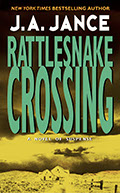 BUY NOWHIGH ON A CLIFF THE SHOOTER PANNED HIS NIGHT SCOPE BACK AND FORTH ACROSS THE SAN PEDRO VALLEY
BUY NOWHIGH ON A CLIFF THE SHOOTER PANNED HIS NIGHT SCOPE BACK AND FORTH ACROSS THE SAN PEDRO VALLEY
Sheriff Joanna Brady is the law in Cochise County, and she will never allow her personal trials to interfere with the job she was elected to do–especially now that death has invaded Bisbee, Arizona, and has shattered the small desert town’s fragile peace. A gun dealer has died violently, and his stock of high-powered weapons has been cleaned out. Suspicion falls upon rancher Alton Hosfield, an armed separatist at war with the federal government and the local law–with everyone, in fact, whom he perceives as a threat to his independent way of life.
Joanna Brady suspects the solution is not so cut-and-dried especially when the cold-blooded slaying is followed by a series of others, equally horrific and perplexing. At best, an incendiary “Ruby Ridge” situation is brewing. At worst, a maniacal serial killer has come to feed on the unsuspecting community. But Joanna’s preoccupation with bringing a murderer to justice could take a terrible toll on her private life . . .and unravel threads of family, love, and responsibility that might never again be retied.
When it comes time to write a book, I usually start with the title. Then, once I find out who’s dead, I spend the rest of the book trying to find out who killed that person and why. Over the years I’ve learned to have a possible title in mind when my editor calls needing it.
For the Joanna Brady books, I try to use something that has to do with Cochise County–a geographical location or a plant. In this case, when my editor called I had settled on Cascabel Crossing, named for a tiny hamlet called Cascabel along the San Pedro River.
“I don’t like it,” my editor said.
“But you do know what Cascabel means, don’t you?”
“No. What?”
“Rattlesnake,” I replied.
“Well,” she said. I like Rattlesnake Crossing.”
“But there’s no place in Cochise County named Rattlesnake Crossing.”
“You do write fiction,” she reminded me.
And so the book became Rattlesnake Crossing. Not only did I invent the place that gives the book its name, I also invented the Apache legend that goes along with it. I call that writing fiction twice removed.
JAJ
AVON (1998) ISBN 0-380-79247-8
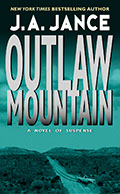 BUY NOWSHE SCREAMED AS NEEDLE-SHARP SPINES PLUNGED DEEP INTO HER PAPER-THIN FLESH, THEN SHE FELL
BUY NOWSHE SCREAMED AS NEEDLE-SHARP SPINES PLUNGED DEEP INTO HER PAPER-THIN FLESH, THEN SHE FELL
Joanna Brady, young widow, devoted mom, and Sheriff of Cochise County, Arizona, is a tough cop who gives no ground to lawbreakers. But now she’s dealing with some big-time political maneuvering that could let someone get away with murder.
When an elderly widow is found dead in the Arizona desert, it’s easy enough to pin the killing on the teens caught driving her car across the Mexican border. But Sheriff Brady isn’t buying it. The victim was a free spirit with a lover twenty years her junior and enough money for her grown kids to fight over.
Joanna is forced to put her personal life on hold to dig deeper into the murder. But as the investigation gets sidetracked by some ugly local land disputes, Sheriff Brady finds herself wading through a murky morass of graft and corruption that reaches into high places, and may have given someone reason to kill . . and kill again.
Cholla is beautiful. Seen backlit by vivid Arizona sunlight, it looks as though each of the branches is surrounded by a heavenly glow, a delicate, golden aura. It’s only closer investigation that reveals the truth. That beautiful glow comes from the needle sharp spines that surround the inner core of the branch. In other words, look but do not touch!
Years ago a friend told me about how in a particularly ugly bit of high school hazing, someone was thrown into a patch of cholla and nearly died as a result of it. Those are the kinds of stories that stay with me and can, given the right circumstances, turn into books years later.
JAJ
AVON (2000) ISBN 0-380-79248-6
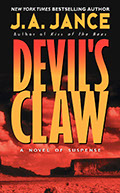 BUY NOWTHE DEVIL PROWLS
BUY NOWTHE DEVIL PROWLS
THE ARIZONA DESERT
HIS NAME IS “MAN”
A piercing ill wind blows hot out of the silent Arizona desert. A Native American woman is dead–an ex-con once jailed for the murder of her husband–and her teenage daughter has vanished into the long shadows of the night-still canyons.
A dedicated law officer, Sheriff Joanna Brady of Cochise County has suffered stoically through loss and pain–yet she has never wavered in her commitment to duty and the pursuit of justice. Now, as she stands on the brink of a new life and new happiness, death is summoning her once more, calling her down a twisted trail of hatred, greed and devastating consequence to the black heart of the Dragoon Mountains. There is no respite yet for Joanna Brady–only a terrifying excursion into a world of passion and violence, where long-buried secrets are the best reasons of all to kill . . .or to die.
My elderly and increasingly frail parents still lived in Bisbee, Arizona when I wrote this. When the need for a Helipad at the local hospital became critical, they, as members of the local Kiwanis Club, began trying to raise money to build one. Hearing of the Helipad Project, I offered to help by doing a local appearance and book-signing. It was soon clear, however, that book-signings and bake sales weren’t going to cut it when it came to raising the required $104,000 inside a two-year deadline.
Remembering how one person had made a $10,000 donation to the YWCA for Breach of Duty, I offered to do the same thing for the Helipad Project in the next Joanna Brady book. My mother was quick to point out, however, that the economic situation in Bisbee was far different from that of Seattle, so I offered to allow people to be included in the book if they made a $1000 donation to the project. Twelve people signed up, and they’re all in this book, under their own names and doing things that are in keeping with their real lives.
As for the Helipad? Phelps Dodge Corporation came through and offered to complete the project for $70,000 less than had been bid originally. And so, if you’re ever in Bisbee, Arizona, and have need of an emergency air-evacuation, you can thank Joanna Brady for being part of the process.
As soon as I saw the cover of the hardback book, I loved it. The blue is the very same blue that’s in the sky as you exit Bisbee’s Mule Mountain Tunnel going north to Tucson. On closer examination, however, I noticed that the bird pictured was an eagle. I called my editor at once. “I love the cover,” I said. “But why is the bird on the cover an eagle when the bird in the book is a red-tailed hawk.”
“Judy,” she said, “when we made the cover, we had no idea there was a bird in the book.”
JAJ
AVON (2001) ISBN 0-380-79249-4
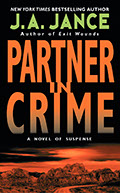 BUY NOWJOANNA BRADY
BUY NOWJOANNA BRADY
J.P. BEAUMONT
TOGETHER AT LAST
An up-and-coming African American artist has been murdered on Sheriff Joanna Brady’s turf in Cochise County, Arizona. Unfortunately the victim happens to be in the Washington State Attorney General’s Witness Protection Program. As the most recent hire in AG’s Special Homicide Investigation Team, J.P. Beaumont gets the call. He reluctantly heads off for Bisbee, Arizona where he tangles not only with Joanna Brady and a contract killer but with some of his own personal demons as well. When two top-drawer and independent minded investigators head-on, you can’t expect the result to be sweetness and light. After all, sometimes having two lead detectives on a single case is one detective too many.
People often want to know where stories come from. Here’s the deal with Partner in Crime.
When Desert Heat, the first Joanna Brady book came out, people began asking me if Arizona’s Sheriff Brady and Seattle’s J.P. Beaumont were ever going to meet. I knew that in order to write such a story, I would have to willingly suspend my disbelief for the six months to a year it would take for me to write such a book. Based on that, my initial reaction was to dismiss the whole idea.
In both fiction and real life, the Cochise County Justice Center is beautifully built. Unfortunately the architect of the real project was longer on aesthetics than he was on security. As a result, he created a jail that didn’t necessarily include a total commitment to keeping jail inmates inside.
Not long after the real facility opened, four jail prisoners let themselves out, went up the road a couple of miles, attacked an elderly couple, tied up the woman, murdered the man, and then stole all the couple’s worldly goods–including their pickup truck. Two days later two of the desperadoes, still driving the stolen pickup, were captured in New Mexico. A year or so later, the third was arrested in Florida. Then, four years later, the fourth was captured in. . . . Tacoma, Washington. The man had been living in the Pacific Northwest long enough to marry. Once he was back in prison in Arizona, his wife staged an ill-fated and, I believe, fatal prison escape attempt.
The next time someone–more specifically my editor–asked me if I could write a book where Beaumont meets Brady, I no longer had the excuse of thinking it could never happen in real life because obviously it could have. As a consequence my disbelief did indeed suspend, and here it is– Beaumont Meets Brady. Enjoy.
JAJ
AVON (2003) ISBN 0-380-80470-0
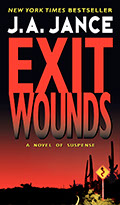 BUY NOWTHE HEAT IS A KILLER IN
BUY NOWTHE HEAT IS A KILLER IN
COCHISE COUNTY, ARIZONA
In the suffocating stillness of an airless trailer, a woman is lying dead, a bullet hole in her chest. Why someone would murder a harmless loner with a soft spot for strays is only one of the questions nagging at the local police; another is why the killer used an eighty-five-year-old bullet, fired from the same weapon that slaughtered two other women who were discovered bound, naked, and gruesomely posed on the remote edge of a rancher′s land.
The slayings are as oppressive as the blistering heat for Sheriff Joanna Brady, who must shoulder the added double burden of a brutal re-election campaign and major developments on the home front. With more on her plate suddenly than many big city law officers have to contend with, she must put marital distractions and an opponent′s dirty tricks in the background and deal with the terrifying reality that now threatens everyone in her jurisdiction: a serial killer in their midst.
Sheriff Brady must pursue this sadistic murderer into the shadows of the past to get to the roots of a monstrous obsession and expose the permanent wounds of a crime far worse than homicide.
When Exit Wounds was due to be published, I knew there would be readers who would refuse to read beyond the preface where the murder victim’s dogs perish of heat prostration in a run-down mobile home. By doing do, those same readers failed to learn about the very human tragedy that often lies behind the newspaper headlines about people who may keep up to dozens of animals in awful, unsanitary, and mostly unintentionally abusive conditions. Animal hoarders think they are “helping” their charges when, in fact, they are doing anything but.
For me, that was the point of the story. Due to their own abusive pasts, many animal hoarders are unable to help themselves any more than they are able to help the unfortunate and often sick and starving animals they have collected. In the course of this last year, I’ve heard from many, many readers who were outraged by the fictional deaths of Carol Mossman’s dogs. I’ve heard from only one reader who addressed the shameful family secret that caused Carol to be the way she was.
In the book there’s a far greater outcry over the dogs’ fates than there is over either the murder victim or over the dozen or so dead and injured illegal immigrants who are spilled out across the desert landscape from a speeding SUV by a people smuggler attempting to elude police pursuit. Not one of the people who wrote to me protesting about what happened to the dogs mentioned a word about what happened to Carol Mossman or the UDAs. I guess it’s a case of life imitating art.
JAJ
AVON (2004) ISBN 0-380-80471-9
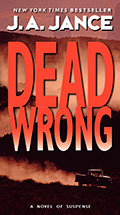 BUY NOWJUGGLING A FAMILY AND A CAREER HAS NEVER BEEN EASY FOR COCHISE COUNTY SHERIFF JOANNA BRADY
BUY NOWJUGGLING A FAMILY AND A CAREER HAS NEVER BEEN EASY FOR COCHISE COUNTY SHERIFF JOANNA BRADY
Now the impending birth of her second child only adds to her burden, especially when two brutal crimes fall under her jurisdiction.
A corpse is discovered in the Arizona desert with the fingers severed from both hands—the body of an ex-con who served twenty years for a murder he claimed not to remember. Soon after, one of Joanna's female officers is savagely assaulted and left for dead while on an unauthorized stakeout. Since the victim is one of their own, the department directs the bulk of its resources toward finding her attacker. But the desert slaying haunts Joanna as well, and neither her pregnancy nor family concerns will keep her from doing her duty, no matter how perilous. Because justice must be served. And enforcing the law has become more than what Joanna Brady does—it's what she is.
As an adult, my brother Jim returned to our home town in Bisbee, Arizona, where he joined the Bisbee fire department. He was named fire fighter of the year twice, once for rescuing a guy who had electrocuted himself on a power line tower and another time for the rescue of a young child who had caught his arm in a sump pump. Because the child was in Naco, across the international border with Mexico, Jim had to coordinate with two governors in order to take US equipment and personnel across the line.
When Jim died of an undiagnosed heart ailment at age 50, his death came as a terrible shock to my parents in particular as well as to the community at large. His funeral, in 2000, was the first fallen officer memorial I ever attended, and I used what I learned there to create the fictional fallen officer memorial in this book. And now you understand the dedication of this book.
JAJ
HARPER (2006) ISBN 0-060-54090-7
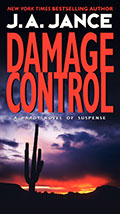 BUY NOWAT FIRST GLANCE,
BUY NOWAT FIRST GLANCE,
IT APPEARS TO BE AN ACCIDENT . . .
A car carrying an elderly couple goes off the side of a mountain and tumbles into oblivion on a beautiful sunny day in the Coronado National Monument. A note pulled from the twisted wreckage suggests the tragedy may have been a double suicide—but an autopsy later suggests something different. A deadly fire and a fatal home invasion may or may not have some connection to the terrible crash. And miles away in the desert, a savage rain has revealed something grisly and terrifying: two trash bags filled with human remains.
It's just another day in the life of Cochise County sheriff Joanna Brady, who must somehow balance the rigors of police work with a newborn, a teenager, a writer-husband, and a difficult mother. But Joanna will not allow murder to go unpunished in her jurisdiction—even if her path to the truth is twisting and dangerous . . . and leads to shocking revelations about those entrusted with caring for the helpless.
My parents, Norman and Evie, loved to take forenoon coffee picnics. Their usual equipment included a frayed oilcloth red and white checked table cloth, an antique thermos, and a pair of Melmac cups they had picked up at a school cafeteria garage sale. Once my mother had poured the coffee, she would pull out the paring knife she customarily carried in her purse and divide a day-old cinnamon roll exactly in half. In 68 years of marriage, I don't believe my parents ever ate a whole cinnamon roll. They always shared.
As a couple, Norman and Evie were nothing if not self-sufficient and independent. Even after they moved into an assisted living facility, they still kept the keys to their Buick, and they planned to use it to make their own Thelma and Louise style exit. That plan was foiled when my father suffered a stroke and died, leaving my mother alone and not the least bit happy about it. She made it blazingly clear to whoever tried to look after her that the one place she wanted to be was with her Norman. When my sister called to say that our mother was gone, I didn't shed a single tear because she was gone--she was where she wanted to be. I went to her funeral and didn't cry at that, either.
But I was starting to write this book. When people from Bisbee read about Albert and Martha, they'll nod knowingly and say, "I don't care what she calls them. Those two people are Norman and Evie Busk." And they'll be right.
In this book, I give Albert and Martha the blessing of the Thelma and Louise exit that was denied my folks, and yes, I did cry when I was writing those scenes.
JAJ
WILLIAM MORROW (2008) ISBN 0-060-74676-9
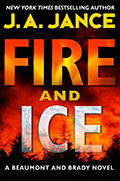 BUY NOWSix young women have been wrapped in tarps, doused with gasoline, and set on fire.
BUY NOWSix young women have been wrapped in tarps, doused with gasoline, and set on fire.
Their charred remains have been scattered around various dump sites, creating a grisly pattern of death across western Washington.
At the same time, thousands of miles away in the Arizona desert, Cochise County sheriff Joanna Brady is looking into a homicide in which the elderly caretaker of an ATV park was run over and left to die. All the man has left behind is his dog, who is the improbable witness to some kind of turf warfare—or possibly something more sinister.
Then a breakthrough in Beaumont's case leads him directly to the Southwest and into Brady's jurisdiction. When the two met on a joint investigation years earlier, sparks flew. Under different circumstances, both of them admit, even more could have happened.
But here, as the threads of their two seemingly separate cases wind together, Beaumont and Brady must put aside echoes of their shared past as they are once again drawn into an orbit of deception.
Cochise County, both in fiction and in real life, shares an 80 mile border with Mexico. I don't think I'm wrong when I say that smuggling both people and drugs is the county's biggest cash crop. Once the illicit drugs or immigrants land inside the US, the interstates become the distribution routes. With Bisbee on the southern end of that traffic and with Seattle at the far northern reaches, it's only natural the my two characters, J. P. Beaumont and Joanna Brady, would cross paths occasionally. This is the second Brady and Beaumont book.
JAJ
WILLIAM MORROW (2009) ISBN 978-0061239229
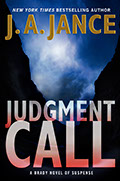 BUY NOWWhen Joanna Brady's daughter, Jenny, stumbles across the body of her high school principal, Debra Highsmith, in the desert, the Cochise County sheriff's personal and professional worlds collide, forcing her to tread the difficult middle ground between being an officer of the law and a mother. While investigating murders has always meant discovering unpleasant facts and disquieting truths, the experienced Joanna isn't prepared for the knowledge she's about to uncover. Though she's tried to protect her children from the dangers of the grown-up world, the search for justice leads straight to her own door and forces her to face the possibility that her beloved daughter may be less perfect than she seems—especially when a photo from the crime scene ends up on Facebook. A photo only one person close to the crime scene could have taken.
BUY NOWWhen Joanna Brady's daughter, Jenny, stumbles across the body of her high school principal, Debra Highsmith, in the desert, the Cochise County sheriff's personal and professional worlds collide, forcing her to tread the difficult middle ground between being an officer of the law and a mother. While investigating murders has always meant discovering unpleasant facts and disquieting truths, the experienced Joanna isn't prepared for the knowledge she's about to uncover. Though she's tried to protect her children from the dangers of the grown-up world, the search for justice leads straight to her own door and forces her to face the possibility that her beloved daughter may be less perfect than she seems—especially when a photo from the crime scene ends up on Facebook. A photo only one person close to the crime scene could have taken.
The gruesome picture is just the tip of the iceberg. Even a small, close-knit town like Bisbee has its secrets. Navigating her way through the unfamiliar world of social media, Joanna discovers shocking—and incriminating—information. The details build, from a hushed-up suspension, to a group of teenagers with a grudge against the late Ms. Highsmith, to a hateful video calling for the principal's death. The video evidence points to one particular privileged boy, who's already lawyered up thanks to his father, a well-to-do doctor determined to protect his son's reputation. Yet the deeper Joanna digs, the more complications she uncovers. It seems the quiet, upstanding principal had a hidden past, full of mysterious secrets she'd successfully kept buried for years.
As the seasoned sheriff juggles professional constraints and personal demands—budget cuts, new team members, an arrogant coroner, a confused teenager, a precocious toddler, and a high-maintenance mother—she finds herself walking a fine line between justice and family that has never been so blurred.
Joanna Brady was fifteen years old when her father, D.H. Lathrop, died, and she has spent the better part of the next two decades at war with her mother Eleanor--the last parent standing. If a child is young when the first parent dies, that the dead parent is immediately elevated to sainthood status. Nothing they ever did or said was wrong, and questioning any of that is entirely taboo. After all, no one is allowed to speak ill of the dead. In the meantime, the person who didn't die--the last parent standing--is also left holding the bag. He or she is expected and required to pick up the pieces and carry on with life. More often than not, in that role--one that was never wanted or expected--he or she becomes the embodiment of Evil. As for me? When it coms to being the last parent standing, I've been there, done that, got the tee-shirt.
As Joanna has matured in the course of fifteen books, she's begun to have a more realistic idea about both her parents. She's finally begun to see that her father wasn't perfection itself just as her mother wasn't perfectly evil. In Judgment Call, all those old ghosts show up again. With any kind of luck, they've all been put out to pasture on a permanent basis.
WILLIAM MORROW (2012) ISBN 0061731161
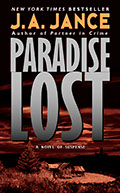 BUY NOWSHERIFF JOANNA BRADY FACES HER MOST PERSONAL AND DANGEROUS CASE WHEN HER DAUGHTER DISCOVERS A BODY IN THE ARIZONA WILDERNESS.
BUY NOWSHERIFF JOANNA BRADY FACES HER MOST PERSONAL AND DANGEROUS CASE WHEN HER DAUGHTER DISCOVERS A BODY IN THE ARIZONA WILDERNESS.
When Cochise County, Arizona, Sheriff Joanna Brady′s daughter Jenny goes off on a Memorial Day weekend girl scout camp-out in nearby Apache Pass, Joanna trusts that her 12-year-old daughter will behave. But with boy-crazy Dora Matthews as a tent-mate, Jenny is seduced into taking a late night unauthorized hike into the wilderness where--instead of smoking a clandestine cigarette--she and Dora stumble upon the body of a murdered Phoenix woman.
Knowing that her little girl will be traumatized by her experience, Joanna must balance concern for Jenny with the demands of her new marriage and possible bid for reelection. But when young Dora Matthews herself turns up dead two days later, Joanna′s concern turns to terror. For if Constance Haskell′s killer is murdering potential witnesses, Jenny may be next.
In Brownies I made one of the world's ugliest sit-upons--two squares of butt-sized red naugahyde sewn together with white yarn and then stuffed with cotton batting. What made mine ugly was the stitching. The stitching on the first side was carefully and evenly done. The second side was less so, while the third and fourth sides were a disgrace. Naturally, I was picturing that ugly thing when I wrote the first camping scenes in this book.
When the book tour came along, I was in the process of doing a Sunday afternoon book signing at the Joseph Beth store in Louisville, Kentucky when my phone rang. I carry my cell phone in my bra. When the phone rang, people in the audience looked at one another as if to say, "Whose phone is that?" But I knew it was mine. In my bra. Finally I pulled it out, but when I looked at the read-out, I could see that the caller was none other than my mother. As long as my mother was on the planet, I tried to call her every Sunday without fail.
"I'm sorry," I said to the people in the audience. "It's my mother. She's in her eighties. I have to take this."
"Hello," I said.
"Where are you?" my mother asked.
"I'm in Louisville, Kentucky, doing a book signing."
"Well," she said, "aren't you glad that all those years ago I saved your sit-upon so that now you have something to write about."
AVON (2002) ISBN 0-380-80469-7
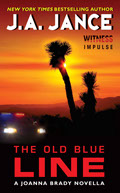 BUY NOWBUTCH DIXON HAS BEEN
BUY NOWBUTCH DIXON HAS BEEN
TAKEN FOR A RIDE …
Not a jump in the car, see the sights kind of ride. He's been taken for everything he has.
He's lost his house, his restaurant business, his savings, his car, his best friend, his faith—all to his conniving ex-wife. But that was seven years ago. He picked himself up, left Chicago, and started over in Peoria, Arizona, running the Roundhouse Bar and Grill. He doesn't look back on those bad years; there's no point. Not until two curious cops show up at the Roundhouse.
Faith, Butch's ex-wife, has been murdered, and the evidence points to him. Stunned, Butch quickly realizes that the black-hearted woman is going to ruin him again, from her grave. Lucky for Butch, the Old Blue Line, a group of retired—but still sharp and tenacious—former legal and law enforcement coots, have taken it upon themselves, as a favor, to make sure he doesn't cross that thin line. After the dust settles, Butch's life is again upended—when a little red-haired ball of fire, Sheriff Joanna Brady, takes a seat at his bar.
While signing books at the 2014 Tucson Festival of Books, a fan asked, "When are we going to see some writing from Butch Dixon?" Sometimes, that's all it takes--having a person ask the right question at the right time.
I think of The Old Blue Line as something akin to Butch Dixon Tells All. In it, we meet Butch as the owner of The Roundhouse Bar and Grill in Surprise, Arizona, in the weeks leading up to his meeting Joanna. This is Butch's story, told in the first person and from his point of view. For me it was a fun way to explore Butch Dixon's background.
E-BOOK & AUDIO, WITNESS IMPULSE / HARPER COLLINS, JUNE 17, 2014, ASIN: B00JOGB2GW
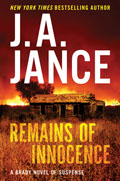 BUY NOWWHEN INNOCENCE IS LOST
BUY NOWWHEN INNOCENCE IS LOST
ALL IS LOST
Sheriff Joanna Brady must solve two perplexing cases that may be tied together in a thrilling tale of suspense that brings to life Arizona’s Cochise County and the desert Southwest in all its beauty and mystery.
An old woman, a hoarder, is dying of emphysema in Great Barrington, Massachusetts. In cleaning out her house, her daughter, Liza Machett, discovers a fortune in hundred dollar bills hidden in the tall stacks of books and magazines that crowd every corner.
Tracing the money’s origins will take Liza on a journey that will end in Cochise County, where Sheriff Joanna Brady is embroiled in a personal mystery of her own. A man she considers a family friend is found dead at the bottom of a hole in a limestone cavern near Bisbee. And now there is the mystery of Liza and the money. Are the two disparate cases connected? It’s up to Joanna to find out.
I remember Bisbee's Warren business district from my childhood. The grocery stores in that two block area were Phelps Dodge Mercantile and MidTown Market. Warren Drug, complete with a soda fountain, was on the corner of a row of small storefronts. Next to that was Endicott's Barber and Beauty Shop, a husband and wife operation; next to that was the Warren Post Office; and beyond that was Pearl Wilcox's Gift Shop. Across the street, next to MidTown market, was Mrs. Browders--a tiny but beloved general store specializing in afternoon candy and treats for kids walking home from school. And let's not forget Mrs. Haynes's Snow Cone shop.
There was a developmentally disabled man whose widowed mother lived just up the street from Bisbee's Warren business district. I seem to remember that the disabled man's name was Charlie. I could be wrong about that, but what I do remember is that those two blocks were the sum total of his world. He hung out there, day after day, either leaning against the various store fronts or patrolling Arizona Street on his fat-tired bike. He always wore perfectly pressed khaki shirts and pants. There was always a toy Roy Roger's pistol on his hip and a gold sheriff's badge pinned to the pocket of his shirt. Was the badge a real one--in memory of a father or uncle perhaps who had been in law enforcement--or was it, too, just a toy? I don't know. I wish now I had thought to ask someone about that. I couldn't have asked Charlie directly because his movements were jerky and his speech mostly incomprehensible. His mother might have understood what he was saying, but outsiders did not.
When I was young, Charlie seemed harmless--riding up and down the street on his bike and engaging in disjointed conversations with people no one else could see. By the time I was in high school, though, Charlie changed. He became scary, often shouting at people as they hurried past him, looking the other way and trying to avoid eye contact. Eventually Charlie disappeared. He may have died, but I don't remember there being a funeral service of any kind.
It's taken me years to learn that the alarming changes in Charlie's behavior probably resulted from a kind of early onset dementia, an additional burden that plagues many developmentally disabled folks. I wish I had been more understanding about Charlie back then, and I wish I had done something to help his mother. I suspect that writing Junior's story in Remains of Innocence is my way of making good on those wishes.
HARDCOVER, WILLIAM MORROW, JULY 22, 2014, ISBN-13: 978-006213470
Desert Heat
Tombstone Courage
Shoot/Don't Shoot
Dead to Rights
Skeleton Canyon
Rattlesnake Crossing
Outlaw Mountain
Devil's Claw
Partner in Crime
Exit Wounds
Dead Wrong
Damage Control
Fire and Ice
Judgment Call
Paradise Lost
The Old Blue Line
Remains of Innocence
AUTOGRAPHED COPIES
BOOK LIST
PUBLISHER J.A. Jance PAGES
SHORT STORIES & INDIE BOOKSTORES